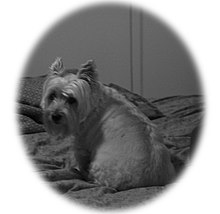
Human life expectancy is a statistical measure of the estimate of the average remaining years of life at a given age. The most commonly used measure is life expectancy at birth. This can be defined in two ways. Cohort LEB is the mean length of life of a birth cohort and can be computed only for cohorts born so long ago that all their members have died. Period LEB is the mean length of life of a hypothetical cohort assumed to be exposed, from birth through death, to the mortality rates observed at a given year. National LEB figures reported by national agencies and international organizations for human populations are estimates of period LEB.

The Samoyed is a breed of medium-sized herding dogs with thick, white, double-layer coats. They are spitz-type dogs which take their name from the Samoyedic peoples of Siberia. Descending from the Nenets Herding Laika, they are domesticated animals that assist in herding, hunting, protection and sled-pulling.

Longevity may refer to especially long-lived members of a population, whereas life expectancy is defined statistically as the average number of years remaining at a given age. For example, a population's life expectancy at birth is the same as the average age at death for all people born in the same year.
Maximum life span is a measure of the maximum amount of time one or more members of a population have been observed to survive between birth and death. The term can also denote an estimate of the maximum amount of time that a member of a given species could survive between birth and death, provided circumstances that are optimal to that member's longevity.

The Bullmastiff is an English breed of dog of mastiff type and large size, with a solid build and a short muzzle. It was developed as a guard dog in the nineteenth century by cross-breeding the English Mastiff with the now-extinct Old English Bulldog. It was recognised as a breed by The Kennel Club in 1924.

The Boxer is a medium to large, short-haired dog breed of mastiff-type, developed in Germany. The coat is smooth and tight-fitting; colors are fawn, brindled, or white, with or without white markings. Boxers are brachycephalic, have a square muzzle, mandibular prognathism, very strong jaws, and a powerful bite ideal for hanging on to large prey. The Boxer was bred from the Old English Bulldog and the now extinct Bullenbeisser, which became extinct by crossbreeding rather than by a decadence of the breed. The Boxer is a member of both The Kennel Club and American Kennel Club (AKC) Working Group.

The Bernese Mountain Dog is a large dog breed from Bern, Switzerland and the Swiss Alps, being one of the four breeds of Sennenhund-type dogs, with roots in the Roman mastiffs. The name Berner refers to the breed's area of origin in the canton of Bern, and Sennenhund is derived from the German Senne and Hund ("hound/dog"), as they accompanied the alpine herders and dairymen called Senn. This breed was originally kept as a general farm dog and large Sennenhunde in the past were also used as draft animals pulling carts. The breed was officially established in 1912.

The Okinawa diet describes the traditional dietary practices of indigenous people of the Ryukyu Islands, which were claimed to have contributed to their relative longevity over a period of study in the 20th century.
Neutering, from the Latin neuter, is the removal of a non-human animal's reproductive organ, either all of it or a considerably large part. The male-specific term is castration, while spaying is usually reserved for female animals. Colloquially, both terms are often referred to as fixing. In male horses, castrating is referred to as gelding. An animal that has not been neutered is sometimes referred to as entire or intact.

A mongrel, mutt, or mixed-breed dog is a dog that does not belong to one officially recognized breed, including those that result from intentional breeding. Although the term mixed-breed dog is sometimes preferred, many mongrels have no known purebred ancestors.

The Dobermann is a German breed of medium-large domestic dog of pinscher type. It was originally bred in Thuringia in about 1890 by Louis Dobermann, a tax collector. It has a long muzzle and – ideally – an even and graceful gait. The ears were traditionally cropped and the tail docked, practices which are now illegal in many countries.

The health of dogs is a well studied area in veterinary medicine.

A mammary tumor is a neoplasm originating in the mammary gland. It is a common finding in older female dogs and cats that are not spayed, but they are found in other animals as well. The mammary glands in dogs and cats are associated with their nipples and extend from the underside of the chest to the groin on both sides of the midline. There are many differences between mammary tumors in animals and breast cancer in humans, including tumor type, malignancy, and treatment options. The prevalence in dogs is about three times that of women. In dogs, mammary tumors are the second most common tumor over all and the most common tumor in female dogs with a reported incidence of 3.4%. Multiple studies have documented that spaying female dogs when young greatly decreases their risk of developing mammary neoplasia when aged. Compared with female dogs left intact, those spayed before puberty have 0.5% of the risk, those spayed after one estrous cycle have 8.0% of the risk, and dogs spayed after two estrous cycles have 26.0% of the risk of developing mammary neoplasia later in life. Overall, unspayed female dogs have a seven times greater risk of developing mammary neoplasia than do those that are spayed. While the benefit of spaying decreases with each estrous cycle, some benefit has been demonstrated in female dogs even up to 9 years of age. There is a much lower risk in male dogs and a risk in cats about half that of dogs.

The dog is a domesticated descendant of the wolf. Also called the domestic dog, it is derived from extinct gray wolves, and the gray wolf is the dog's closest living relative. The dog was the first species to be domesticated by humans. Experts estimate that hunter-gatherers domesticated dogs more than 15,000 years ago, which was before the development of agriculture. Due to their long association with humans, dogs have expanded to a large number of domestic individuals and gained the ability to thrive on a starch-rich diet that would be inadequate for other canids.
Canine reproduction is the process of sexual reproduction in domestic dogs, wolves, coyotes and other canine species.
Aging in cats is the process by which cats change over the course of their natural lifespans. The average lifespan of a domestic cat may range from 13 to 20 years. As cats senesce, they undergo predictable changes in health and behavior. Dental disease and loss of olfaction are common as cats age, affecting eating habits. Arthritis and sarcopenia are also common in older cats. How a cat's health is affected by aging may be managed through modifications in a cat's diet, accessibility adjustments, and cognitive stimulation.

Cancer is the leading cause of death in dogs. It is estimated that 1 in 3 domestic dogs will develop cancer, which is the same incidence of cancer among humans. Dogs can develop a variety of cancers and most are very similar to those found in humans. Dogs can develop carcinomas of epithelial cells and organs, sarcomas of connective tissues and bones, and lymphomas or leukemias of the circulatory system. Selective breeding of dogs has led certain pure-bred breeds to be at high-risk for specific kinds of cancer.

The Chihuahua is a Mexican breed of toy dog. It is named for the Mexican state of Chihuahua and is among the smallest of all dog breeds. It is usually kept as a companion animal or for showing.
The disposable soma theory of aging states that organisms age due to an evolutionary trade-off between growth, reproduction, and DNA repair maintenance. Formulated by Thomas Kirkwood, the disposable soma theory explains that an organism only has a limited amount of resources that it can allocate to its various cellular processes. Therefore, a greater investment in growth and reproduction would result in reduced investment in DNA repair maintenance, leading to increased cellular damage, shortened telomeres, accumulation of mutations, compromised stem cells, and ultimately, senescence. Although many models, both animal and human, have appeared to support this theory, parts of it are still controversial. Specifically, while the evolutionary trade-off between growth and aging has been well established, the relationship between reproduction and aging is still without scientific consensus, and the cellular mechanisms largely undiscovered.
This timeline lists notable events in the history of research into senescence or biological aging, including the research and development of life extension methods, brain aging delay methods and rejuvenation.















